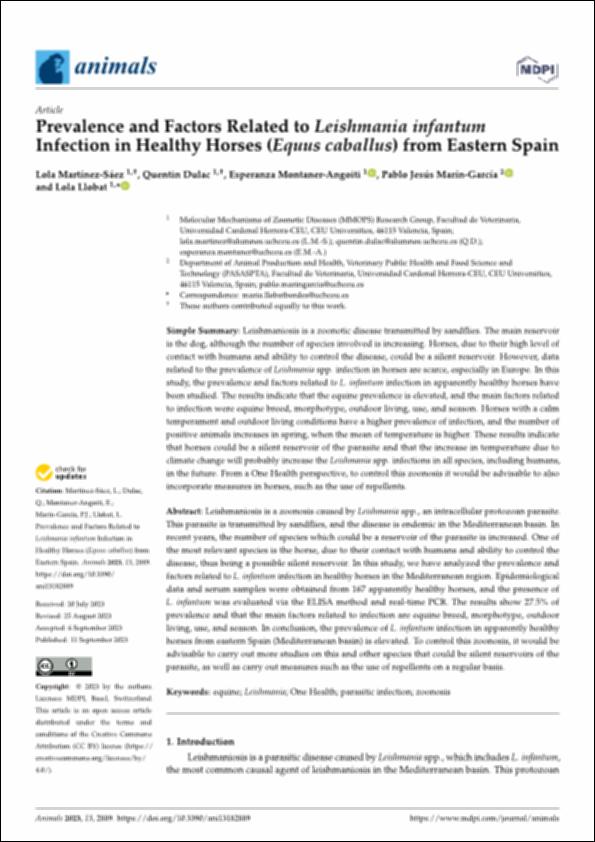Please use this identifier to cite or link to this item:
http://hdl.handle.net/10637/16065Prevalence and factors related to "Leishmania infantum" infection in healthy horses ("Equus caballus") from Eastern Spain
| Title: | Prevalence and factors related to "Leishmania infantum" infection in healthy horses ("Equus caballus") from Eastern Spain |
| Authors : | Martínez Sáez, Lola Dulac, Quentin Montaner Angoiti, Esperanza Marín García, Pablo Jesús Llobat Bordes, Lola |
| Keywords: | Zoonosis; Zoonoses; Caballos; Horses; Leishmaniosis; Leishmaniasis; Enfermedad animal; Animal diseases; Enfermedad transmisible; Infectious diseases |
| Publisher: | MDPI |
| Citation: | Martínez-Sáez, L., Dulac, Q., Montaner-Angoiti, E., Marín-García, P.J. & Llobat, L. (2023). Prevalence and factors related to "Leishmania infantum" infection in healthy horses ("Equus caballus") from Eastern Spain. Animals, vol. 13, i. 18, art. 2889 (11 sep.). DOI: https://doi.org/10.3390/ani13182889 |
| Abstract: | Leishmaniosis is a zoonosis caused by Leishmania spp., an intracellular protozoan parasite. This parasite is transmitted by sandflies, and the disease is endemic in the Mediterranean basin. In recent years, the number of species which could be a reservoir of the parasite is increased. One of the most relevant species is the horse, due to their contact with humans and ability to control the disease, thus being a possible silent reservoir. In this study, we have analyzed the prevalence and factors related to L. infantum infection in healthy horses in the Mediterranean region. Epidemiological data and serum samples were obtained from 167 apparently healthy horses, and the presence of L. infantum was evaluated via the ELISA method and real-time PCR. The results show 27.5% of prevalence and that the main factors related to infection are equine breed, morphotype, outdoor living, use, and season. In conclusion, the prevalence of L. infantum infection in apparently healthy horses from eastern Spain (Mediterranean basin) is elevated. To control this zoonosis, it would be advisable to carry out more studies on this and other species that could be silent reservoirs of the parasite, as well as carry out measures such as the use of repellents on a regular basis. |
| Description: | Este artículo pertenece a la sección " Equids". |
| URI: | http://hdl.handle.net/10637/16065 |
| Rights : | http://creativecommons.org/licenses/by/4.0/deed.es Open Access |
| ISSN: | 2076-2615 (Electrónico) |
| Issue Date: | 11-Sep-2023 |
| Center : | Universidad Cardenal Herrera-CEU |
| Appears in Collections: | Dpto. Producción y Sanidad Animal, Salud Pública Veterinaria y Ciencia y Tecnología de los Alimentos |
Items in DSpace are protected by copyright, with all rights reserved, unless otherwise indicated.


